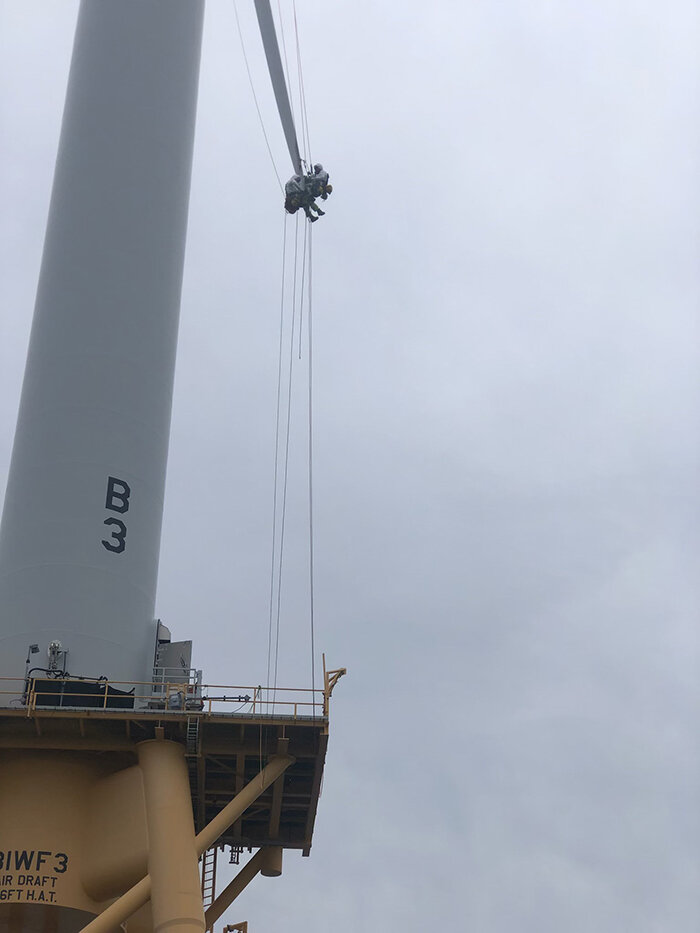Block Island Wind Turbines Motionless Due to ‘Routine Summer Maintenance’
By CAITLIN FAULDS/ecoRI News staff

Four of the Block Island Wind Farm’s five turbines have been shutdown for much of the summer. (Ørsted)
The wind turbines off the coast of
Block Island — known to many as the crown jewel of the burgeoning U.S. offshore
wind energy industry — have gone still.
The Block Island Wind Farm turbines, 3 miles
southeast of Block Island, have been mostly in motion since their launch in
2016. But over the past several weeks, fishermen and islanders have noticed the
73-meter-long blades of four of the five turbines remain frozen in place.
The Block Island Wind Farm’s five 840-foot-tall wind turbines comprise the first operational offshore wind facility in the United States. The turbines were manufactured by General Electric subsidiary GE Renewable Energy, while the wind facility was still under the ownership of Deepwater Wind.
In
2018, Deepwater Wind was acquired by Danish multinational utility company
Ørsted, putting the Block Island Wind Farm in the hands of the world’s largest
offshore wind developer.
Chris Raia, senior account executive
with Providence-based public relations firm Duffy & Shanley, which
represents Ørsted, said the turbines were shut down for the repair of “stress
lines identified by GE in the turbines.”
“We put four turbines on pause as a precautionary measure and carried out a full risk assessment, which showed the turbines are structurally sound,” Raia said. “We expect to complete those repairs and all maintenance in the next few weeks as scheduled.”
He noted the repairs were in line
with routine maintenance, which often occurs during the “optimal” summer
months.
Concern over the structural
integrity of the five Haliade 150-6MW turbines started in 2015, shortly
after construction began. A September 2015 report by
Houston-based ABS Group, a technical advisor and design verification consultant
hired to monitor the facility’s construction, detailed broken testing
equipment, unused moisture-extraction ovens, a dearth of documentation, and
unverified welding practices.
Rhode Island Coastal Resources
Management Council board members at the time described the practices as “very
concerning.”
In 2019, reports emerged that a
high-voltage undersea cable linking the Block Island Wind Farm to the mainland
was surfacing on Block Island beaches. National Grid, which owns the power line
joining New Shoreham to Narragansett, said line reburial would cost $30 million.
Repairs were incomplete and paused entering this
summer’s tourism season.
 |
| Fishermen have reported seeing workers hanging from turbine blades. (Courtesy photo) |
Bonnie Brady, board member of the Responsible Offshore Development Alliance and executive director of the Long Island Commercial Fishing Association, which opposed the project, worries that issues during the turbines’ construction, including the welding incongruencies, have surfaced.
Brady said she has received reports from numerous fishermen regarding work being performed on the turbines.
These
secondhand accounts claim workers in hazmat suits were hanging from turbine
blades and a brown substance was seen on the turbines.
Jeffery Wright, president of the
Block Island Power Co., said questions coming in from residents and tourists
regarding the stationary turbines have recently increased “about 300 percent.”
“We notice them shut down from time
to time,” he said. It’s not an unusual occurrence, though he said this summer’s
shutdowns have stretched a little longer than normal.
The facility is estimated to produce
about 125,000 megawatt-hours annually, enough to power about 17,000 homes.
Wright said New Shoreham has experienced no depletion of its power supply in
recent months. The island is connected to mainland power supplies via submarine
cables. On-island solar panels also contribute to a stable energy supply, he
said.
“Our lights are still on,” Wright
said.